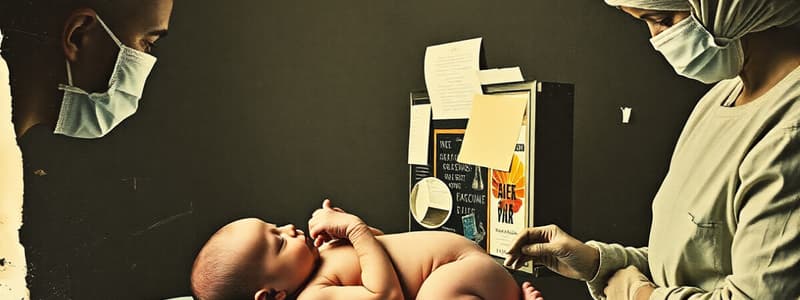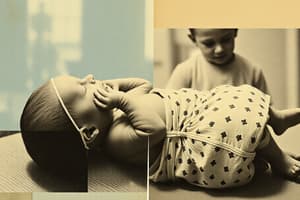Podcast
Questions and Answers
Which characteristic is NOT normally expected when assessing a newborn's neck?
Which characteristic is NOT normally expected when assessing a newborn's neck?
- Surrounded by skin folds
- Short and thick
- Free movement
- Webbing present (correct)
What indicates normal gastrointestinal function in a newborn?
What indicates normal gastrointestinal function in a newborn?
- Absence of bowel sounds
- Nondistended abdomen (correct)
- Umbilical cord with strong odor
- Intestinal structures visible
At what age is the Sucking and Rooting Reflex expected to disappear?
At what age is the Sucking and Rooting Reflex expected to disappear?
- 1-2 months
- At birth
- 6 months
- 3-4 months (correct)
Which of the following reflexes is expected to be present from birth until about 1 year?
Which of the following reflexes is expected to be present from birth until about 1 year?
Which assessment finding would NOT indicate typical muscle development in newborns?
Which assessment finding would NOT indicate typical muscle development in newborns?
How long does the Symmetrical Tonic Neck Reflex typically remain complete in a newborn?
How long does the Symmetrical Tonic Neck Reflex typically remain complete in a newborn?
Which reflex is characterized by fanning of the toes when the outer edge of the sole is stroked?
Which reflex is characterized by fanning of the toes when the outer edge of the sole is stroked?
What outcome indicates that a newborn's head control is intact?
What outcome indicates that a newborn's head control is intact?
What does the classification 'Small for Gestational Age' (SGA) indicate?
What does the classification 'Small for Gestational Age' (SGA) indicate?
What is the normal respiratory rate for newborns?
What is the normal respiratory rate for newborns?
At what gestational age range is a newborn considered 'Early Term'?
At what gestational age range is a newborn considered 'Early Term'?
Which of the following best characterizes 'Intrauterine Growth Restriction' (IUGR)?
Which of the following best characterizes 'Intrauterine Growth Restriction' (IUGR)?
What does a significantly high heart rate in a newborn generally indicate?
What does a significantly high heart rate in a newborn generally indicate?
Which vital sign assessment is performed first in the sequence?
Which vital sign assessment is performed first in the sequence?
What is the significance of the classification 'Large for Gestational Age' (LGA)?
What is the significance of the classification 'Large for Gestational Age' (LGA)?
What is the normal temperature range for newborns?
What is the normal temperature range for newborns?
What is the primary purpose of the New Ballard Score in newborn assessment?
What is the primary purpose of the New Ballard Score in newborn assessment?
Which classification indicates a newborn whose weight is greater than the 90th percentile?
Which classification indicates a newborn whose weight is greater than the 90th percentile?
Which weight range is considered normal for newborns at birth?
Which weight range is considered normal for newborns at birth?
What is assessed in the neuromuscular maturity part of the New Ballard Score?
What is assessed in the neuromuscular maturity part of the New Ballard Score?
What does a score of 35 on the New Ballard Score indicate?
What does a score of 35 on the New Ballard Score indicate?
When is gestational age assessment ideally performed for newborns?
When is gestational age assessment ideally performed for newborns?
Which of the following is NOT a parameter assessed in the physical maturity aspect of the New Ballard Score?
Which of the following is NOT a parameter assessed in the physical maturity aspect of the New Ballard Score?
Flashcards
Gestational Age Assessment
Gestational Age Assessment
Assessment performed within 48 hours of birth to predict neonatal health risks.
New Ballard Score
New Ballard Score
Assessment of newborn's neuromuscular and physical maturity, estimating the gestational age.
Appropriate for Gestational Age (AGA)
Appropriate for Gestational Age (AGA)
Newborn's weight falls between the 10th and 90th percentile for their gestational age.
Small for Gestational Age (SGA)
Small for Gestational Age (SGA)
Signup and view all the flashcards
Large for Gestational Age (LGA)
Large for Gestational Age (LGA)
Signup and view all the flashcards
Male Genitalia Development
Male Genitalia Development
Signup and view all the flashcards
Physical Maturity
Physical Maturity
Signup and view all the flashcards
Neuromuscular Maturity
Neuromuscular Maturity
Signup and view all the flashcards
What is a newborn's normal respiratory rate?
What is a newborn's normal respiratory rate?
Signup and view all the flashcards
What are signs of respiratory distress in a newborn?
What are signs of respiratory distress in a newborn?
Signup and view all the flashcards
What is the normal heart rate for a newborn?
What is the normal heart rate for a newborn?
Signup and view all the flashcards
Where is the apical pulse assessed in a newborn?
Where is the apical pulse assessed in a newborn?
Signup and view all the flashcards
What is the normal blood pressure for a newborn?
What is the normal blood pressure for a newborn?
Signup and view all the flashcards
What is the normal temperature range for a newborn?
What is the normal temperature range for a newborn?
Signup and view all the flashcards
What are newborns at risk for until thermoregulation stabilizes?
What are newborns at risk for until thermoregulation stabilizes?
Signup and view all the flashcards
What is the sequence for assessing vital signs in a newborn?
What is the sequence for assessing vital signs in a newborn?
Signup and view all the flashcards
Neck Assessment: What to look for?
Neck Assessment: What to look for?
Signup and view all the flashcards
Abdomen Assessment: Normal?
Abdomen Assessment: Normal?
Signup and view all the flashcards
Extremities Assessment: What's normal?
Extremities Assessment: What's normal?
Signup and view all the flashcards
Gluteal Folds: What to check?
Gluteal Folds: What to check?
Signup and view all the flashcards
Sucking and Rooting Reflex: When does it disappear?
Sucking and Rooting Reflex: When does it disappear?
Signup and view all the flashcards
Palmar Grasp Reflex: What is it?
Palmar Grasp Reflex: What is it?
Signup and view all the flashcards
Plantar Grasp Reflex: When does it disappear?
Plantar Grasp Reflex: When does it disappear?
Signup and view all the flashcards
Moro Reflex: What is it?
Moro Reflex: What is it?
Signup and view all the flashcards
Study Notes
Apgar Scoring
- A quick system review of newborn systems at 1 and 5 minutes post-birth
- Determines extrauterine adaptation, guiding interventions
- Scores range 0-3 (severe distress), 4-6 (moderate difficulty), 7-10 (minimal/no difficulty)
- Five criteria: heart rate, respiratory rate, muscle tone, reflex irritability, and color
- Each criterion rated 0-2, with a total score indicating newborn condition
- Example: heart rate 120, good cry, pink skin, would score 10
- Consider genetic background for accurate color assessment
Newborn Assessment Overview
- Understanding newborn physiologic response to birth essential for nursing care
- Key elements include Apgar score, physical exam, Ballard Score, vital signs, and complications
- Transition to extrauterine life requires respiratory and circulatory system adjustments
- Respiratory function establishment marked by first breath and umbilical cord clamping
- Circulatory adaptation involves closure of ductus arteriosus, ductus venosus, and foramen ovale
- Immediate post-birth assessment critical to identify abnormalities or complications
Equipment for Newborn Assessment
- Bulb syringe for suctioning mucus
- Pediatric stethoscope for heart rate, breath sounds, bowel sounds
- Axillary thermometer for monitoring temperature
- Blood pressure cuff for measuring blood pressure
- Scale for weighing newborns
- Tape measure for length (crown-to-heel) and head circumference
Initial Assessment Procedures
- Quick initial assessment for critical abnormalities
- Skin color, peeling, birthmarks, nasal patency observation
- Chest assessment: breathing, heart and lung sounds auscultation
- Abdominal assessment: umbilical cord, abdomen inspection
- Neurologic assessment: muscle tone, reflexes, fontanel size evaluation
- Document gross structural malformations
Expected Reference Ranges
- Weight: 2,500 to 4,000 grams (5.5 to 8.8 lbs)
- Length: 45 to 55 cm (18 to 22 in)
- Head Circumference: 32 to 36.8 cm (12.6 to 14.5 in)
- Chest Circumference: 30 to 33 cm (12 to 13 in)
Gestational Age Assessment
- Performed within first 48 hours after birth
- Crucial for predicting neonatal morbidity and mortality
- Physical measurements and New Ballard Score used
New Ballard Score
- Assesses neuromuscular and physical maturity
- Each parameter (e.g., neuromuscular, physical) rated -1 to 5
- Total score indicates gestational age in weeks
- Score of 35 indicates approx. 38 weeks gestation
- Helps identify preterm and post-term infants
Classification of Newborns
- Classified by gestational age and birth weight
- Appropriate for Gestational Age (AGA): 10th-90th percentile birth weight
- Small for Gestational Age (SGA): Below 10th percentile birth weight
- Large for Gestational Age (LGA): Above 90th percentile birth weight
Normal Deviations in Skin
- Milia: Small pearly spots on face, usually vanish on their own
- Mongolian Spots: Blue-gray or brown pigmentation, common in darker-skinned infants, typically harmless
- Telangiectatic Nevi (Nevus Flammeus): Flat pink/red marks, typically on the neck or face, usually fade with age
- Capillary Flammeus: Pink marks that do not blanch, often seen on the face, and are permanent unless treated
Vital Signs Assessment
- Sequence: respirations, heart rate, blood pressure, temperature
- Normal respiratory rate: 30-60 breaths/min
- Normal heart rate: 110-160 beats/min
- Normal temperature: 36.5°C to 37.5°C (97.7°F to 99.5°F)
- Abnormal findings like crackles, wheezing, grunting, or nasal flaring indicate respiratory distress
Physical Examination from Head to Toe
- Newborn posture typically curled up with moderate flexion.
- Skin color transitions from deep red to purple (acrocyanosis), especially in first few hours
- Jaundice may appear by day 3 due to increased bilirubin levels (usually resolves spontaneously)
Head Assessment
- Head circumference should be 2-3 cm larger than chest circumference
- Head circumference greater than or equal to 4cm larger than chest circumference may indicate hydrocephalus
- Regular monitoring crucial for neurological development
Caput Succedaneum and Cephalohematoma
- Caput Succedaneum: Localized soft tissue swelling due to birth pressure, resolves in 3-4 days without treatment
- Cephalohematoma: Blood collection between periosteum and skull bone, does not cross suture lines, resolves in 2-8 weeks
Sensory Assessment
- Eye Examination: Symmetry in size, shape, distance between inner/outer canthus, assess for tears, pupillary and red reflexes
- Ear and Nose Assessment: Ear positioning, nasal patency, possible abnormalities
- Oral and Neck Assessment: Palate closure, symmetry, tongue protrusions, presence of neck webbing
Reflexes and Neurological Assessment
- Sucking/Rooting, Palmar/Plantar grasp, Moro, Symmetrical Tonic Neck, Babinski, Stepping reflexes documented
- All reflexes should be present at birth unless there is a developmental delay
Extremities Assessment
- Assessing for full range of motion, symmetrical extremities, evaluating bowed legs, flat feet, and pink nail beds. Absence of extra digits noted
Pain Assessment in Newborns
- CRIES scale and NIPS used to assess pain.
- Behavioral changes like alterations in sleep, feeding, or activity are noted indicators.
- Physiological responses (e.g., increased heart rate, shallow respirations) also evaluated for pain.
Newborn Laboratory Values
- Hgb: 14-24 g/dL
- Platelets: 150,000-300,000/mm³
- Hct: 44-64%
- Glucose: >40-45 mg/dL
- Other laboratory (RBC count, bilirubin) values based on time after birth
Studying That Suits You
Use AI to generate personalized quizzes and flashcards to suit your learning preferences.




